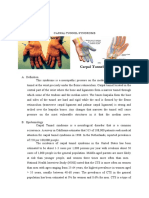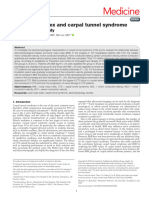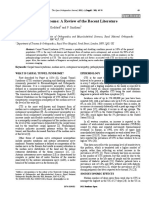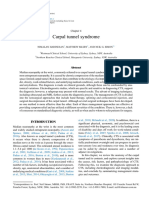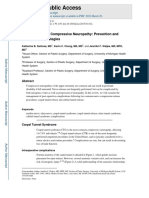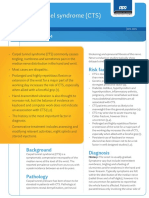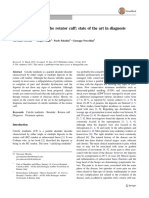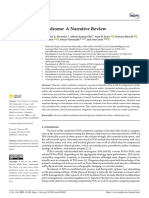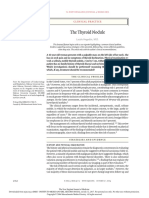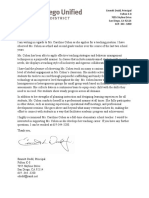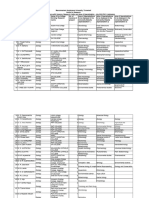6gvqwn
6gvqwn
Uploaded by
ccl2019714Copyright:
Available Formats
6gvqwn
6gvqwn
Uploaded by
ccl2019714Original Title
Copyright
Available Formats
Share this document
Did you find this document useful?
Is this content inappropriate?
Copyright:
Available Formats
6gvqwn
6gvqwn
Uploaded by
ccl2019714Copyright:
Available Formats
Open Access Review
Article DOI: 10.7759/cureus.7333
Carpal Tunnel Syndrome: A Review of Literature
Alessia Genova 1 , Olivia Dix 1 , Asem Saefan 1 , Mala Thakur 1 , Abbas Hassan 2
1. Internal Medicine, Xavier University School of Medicine, Oranjestad, ABW 2. Plastic and Reconstructive Surgery,
Northwestern University Feinberg School of Medicine, Chicago, USA
Corresponding author: Abbas Hassan, abbas.hassan@northwestern.edu
Abstract
Carpal tunnel syndrome (CTS) is a common medical condition that remains one of the most frequently
reported forms of median nerve compression. CTS occurs when the median nerve is squeezed or compressed
as it travels through the wrist. The syndrome is characterized by pain in the hand, numbness, and tingling in
the distribution of the median nerve. Risk factors for CTS include obesity, monotonous wrist activity,
pregnancy, genetic heredity, and rheumatoid inflammation. The diagnosis of CTS is conducted through
medical assessments and electrophysiological testing, although idiopathic CTS is the most typical method of
diagnosis for patients suffering from these symptoms. The pathophysiology of CTS involves a combination
of mechanical trauma, increased pressure, and ischemic damage to the median nerve within the carpal
tunnel. The diagnosis of CTS patients requires the respective medical professional to develop a case history
associated with the characteristic signs of CTS. In addition, the doctor may question whether the patients
use vibratory objects for their tasks, the parts of the arm where the sensations are felt, or if the patient may
already have predisposing factors for CTS incidence. During the diagnosis of CTS, it is essential to note that
other conditions may also provide similar symptoms to CTS, thus requiring vigorous diagnosis to assert the
medical condition of the patients. Doctors use both non-surgical and surgical treatments when addressing
CTS. Non-surgical treatments include wrist splinting, change of working position, medications, and the use
of alternative non-vibrating equipment at work. On the other hand, surgical methods include open release
and endoscopic surgeries. This review of literature has provided an overview of CTS with an emphasis on
anatomy, epidemiology, risk factors, pathophysiology, stages of CTS, diagnosis, and management options.
Categories: General Surgery, Other, Anatomy
Keywords: carpal tunnel syndrome, cts syndrome, diagnostic tools, clinical features, management, carpal tunnel
release
Introduction And Background
Carpal tunnel syndrome (CTS) is a common medical condition, which causes pain, numbness, and tingling
in the hand and arm of the affected individual. CTS occurs when the median nerve is squeezed or
compressed as it travels through the wrist. Risk factors for CTS include obesity, monotonous wrist activity,
pregnancy, genetic heredity, and rheumatoid inflammation [1]. The symptoms for CTS may vary across
Received 03/12/2020 patients. As such, they are classified differently into mild, moderate, and severe. The syndrome is
Review began 03/13/2020 characterized by pain in the hand, numbness, and tingling in the distribution of the median nerve. These
Review ended 03/16/2020 sensations may be felt in the thumb, index finger, middle finger, and the radial side of the ring finger [2]. The
Published 03/19/2020
painful feelings may result in a reduction in grip strength and hand function. The occurrence of CTS over a
© Copyright 2020 long time may also result in the muscles at the base of the thumb wasting away. An estimated 4% and 5% of
Genova et al. This is an open access people suffer from CTS worldwide, with the most susceptible population being elderly individuals aged
article distributed under the terms of the
between 40 and 60 years [3]. CTS is also more prevalent amongst women as compared to men. For instance,
Creative Commons Attribution License
CC-BY 4.0., which permits unrestricted the UK General Practice Research Database in 2000 evaluated that CTS prevalence was 88 per 100,000 in
use, distribution, and reproduction in any males, while in women, the incidence was 193 per 100,000 [2]. More frequent evaluations of the incidence of
medium, provided the original author and CTS notes its occurrence to be higher for women aged between 45 and 54 years, while the risk is higher for
source are credited.
men aged between 75 and 84 years [4]. CTS is a musculoskeletal disorder associated with work activity in the
affected individuals, which is caused by strain and repetitive activity, making it a common problem across
manual laborers. As such, CTS can also be associated with increased absences from work and further
healthcare risks. This review article discusses the anatomy, epidemiology, risk factors, pathophysiology,
stages, diagnosis, and management options of CTS.
Review
Anatomy
The symptoms for CTS may tend to vary, which is the result of the variation in the anatomy. For instance, for
the anatomical differences in the nerves, a bifid median nerve resulting from the high division is noted in 1%
to 3.3% of the cases [3,5]. This is associated with the tenacity of the median artery or with an additional
division of the superficial flexor of the third finger. Another variation is noted in the motor branch of the
median nerve. In this variation, there are five types of starting points and paths of the thenar division. The
most frequent type of variation is the extraligamentous form, which assumes 46% of the cases, while the
subligamentous form accounts for 31%, and the transligamentous form takes 23% of the cases [3,6]. The
How to cite this article
Genova A, Dix O, Saefan A, et al. (March 19, 2020) Carpal Tunnel Syndrome: A Review of Literature. Cureus 12(3): e7333. DOI
10.7759/cureus.7333
nerve bundles intended for the thenar branch may be situated on the radial, anterior, or central part of the
median nerve. In other instances, the thenar branch passes through a tunnel before entering the thenar
muscles. These differences illustrate the inconstant motor effect in cases of severe compression on the
median nerve. Another variation occurs in the palmar cutaneous branch of the median nerve. In this respect,
the palmar cutaneous division often starts from 4 cm to 7 cm above the wrist fold and moves along near the
median nerve for 1.6 to 2.5 cm 3. The branch then enters a tunnel formed by the fascia at the medial edge of
the flexor carpi radialis (FCR) and emerges 0.8 cm above the wrist flexion wrinkle, to innervate the skin of
the thenar eminence. The palmar cutaneous branch may either go to the ulnar side of the median nerve or
cross the transverse ligament of the carpus. Another variation, though rare, is the intratunnel positioning of
the ulnar nerve. In the event of its occurrence, however, the irregularity shows the combined symptoms of
the median and ulnar nerves [7]. Activities of the wrist joint also influence the form and size of the CT.
During the normal range of wrist motion, the width of the tunnel decreases considerably, with the carpal
bones moving relative to each other because of the bony walls of the tunnel being flaccid [8]. Flexion and
extension also cause an increase in CT pressure. Conversely, the cross-section of the proximal opening of
the CT decreases with the flexing of the wrist joint. This is because of the circular changes of the transverse
carpal ligament (TCL) and the movement of the distal end of the capitates bone. Extreme extension causes
the lunate bone to scrunch the passage while being pushed towards the interior part of the tunnel. The TCL
is the dense, diminutive, and broad essential element of the flexor retinaculum (FR), ranging between 2 mm
to 4 mm in thickness, an average width of 25 mm, and 31 mm in length [8-9]. It is a firm band, which forms
from interwoven bundles of fibrous connective tissues. It also spreads from the distal part of the radius to
the distal segment of the base of the third metacarpal. The average closeness to the central portion is 11 mm
away from the capitate-lunate joint, while the average distal limit of the distal portion is 10 mm distal to the
carpometacarpal joint of the third metacarpal [8].
Epidemiology
CTS is the most common entrapment condition affecting one or more peripheral nerves and resulting in
numbness or weakness in the affected body organ. On average, at least 3.8% of people who complain of
aching, unresponsiveness, and an itchy feeling in their hands have CTS [10-11]. Diagnosis for CTS is
conducted through medical assessments and electrophysiological testing, although idiopathic CTS is the
most typical method of diagnosis for patients suffering from these symptoms. In addition, the events of CTS
occurrence occur at a rate of 276 per 100,000 annual reports, with the incidence rates being 9.2% for women
and 6% in men [10,12]. Although CTS incidences are common across all age groups, it is more prevalent for
adults between the age of 40 and 60 years. In regions like the United Kingdom, CTS occurrence is between
7%-16%, which is relatively higher as compared to the 5% incidence rates in the United States [13-14]. Most
western nations indicate a rise in the number of work-related musculoskeletal disorders (WMSDs). This is
associated with increased strain and repetitive movements by individuals. Europe, in 1998, for instance,
reported more than 60% of upper limb musculoskeletal disorders recognized as work-related being CTS
incidences [10]. The prevalence levels may also vary across the different occupations and industries, with
industries, such as the fish processing industries reporting the occurrence of CTS in their workers estimated
at 73% [10]. These views on the occurrence rates of CTS illustrate the weight of the challenge, making it a
significant area of concern, which would require effective strategies for management.
Risk factors
Despite CTS being an idiopathic syndrome, there are still existing risk factors associated with the prevalence
of this medical condition. Notable ecological risk factors include extended positions in excesses of wrist
flexion or extension, monotonous use of the flexor muscles, and exposure to vibration [15]. Unlike
environmental factors, medical risk factors for CTS are classified into four categories. These include extrinsic
factors, which increase the volume within the tunnel on either side of the nerve; intrinsic factors that
increase the volume within the tunnel; extrinsic factors that alter the contour of the tunnel; and neuropathic
factors [15-16]. Increasing rates of CTS events are also attributed to the increased life span for workers, as
well as the increased cases of risk factors, such as diabetes and pregnancies. Extrinsic factors that increase
the volume within the tunnel include circumstances that change the fluid equilibrium within the body. Such
factors include pregnancy, menopause, obesity, kidney failure, hypothyroidism, use of oral contraceptives,
and congestive heart failure. Intrinsic factors within the nerve for increasing the occupied volume inside the
tunnel include lumps and tumor-like strains. These could be the outcomes of fractures of the distal radius,
directly or through posttraumatic arthritis. Neuropathic factors include conditions such as diabetes,
alcoholism, vitamin deficiency or toxicity, and exposure to toxins. These are significant factors since they
affect the median nerve without necessarily increasing the interstitial pressure within the carpal tunnel.
Diabetic patients have a higher propensity to develop CTS since they have a lower onset for nerve injury. In
diabetic patients, the extent of incidence is 14% for patients without diabetes and 30% for patients with
diabetic neuropathy, while the prevalence rate during pregnancy estimates at 2% [17].
Pathophysiology
The pathophysiology of CTS involves a combination of mechanical trauma, increased pressure, and ischemic
damage to the median nerve within the carpal tunnel. Concerning increased pressure, normal pressure is
recorded to vary between 2 mmHg and 10 mmHg. In the carpal tunnel, the change in the position of the
wrist may result in dramatic shifts in the fluid pressure. As such, the extension increases the pressure to
2020 Genova et al. Cureus 12(3): e7333. DOI 10.7759/cureus.7333 2 of 6
more than 10 times its initial level, while flexion of the wrist causes an eight times increase in the pressure
[18]. Resultantly, repetitive motions in the wrist are significant risk factors for CTS incidences. In nerve
injury, on the other hand, a noteworthy step in damage to the median nerve is demyelination, which occurs
when the nerve is frequently exposed to automatic forces [19]. Demyelination of the nerve develops in the
location of compression and spreads to the intermodal segment where the axons are left intact. With
continuous compression, blood flow to the endoneurial capillary system is interrupted, causing alterations
in the blood-nerve barrier and the development of endoneurial edema. As a result, a vigorous cycle begins,
which consists of venous congestion, ischemia, and local metabolic alterations [18-19]. Ischemic injury is
also noted as a significant element in CTS because of the assessment that symptoms rapidly resolve after
carpal tunnel release surgery. Limb ischemia increases paraesthesias in carpal tunnel patients. This occurs in
three phases, including increased intrafunicular pressure, injury to the capillary with leakage and edema,
and obstruction of arterial flow in the patients [19].
Stages of CTS
In the first stage of the clinical diagnosis of CTS, the patient tends to wake up from sleep feeling numbness
or swelling on the hand, with no noticeable swelling. The patient may feel extreme pain from the wrist
spreading to the shoulder, with a tingling in the hand and fingers, which is defined as brachialgia
paresthetica nocturna. On most occasions, the pain ceases after shaking the hand though the hand may feel
firm later. The second stage of CTS development in the patient is the occurrence of symptoms, which occur
in the day. Such symptoms occur when the patient engages in a repetitive activity involving the hand or
wrist or if they maintain a specific position for extended periods [8,20]. Similarly, the patients may also note
clumsiness when using their hands to grip objects, causing them to fall. The final stage of CTS development
appears when there is hypotrophy or atrophy of the thenar eminence [20]. The occurrence of this stage also
entails the ability to engage in any sensory symptoms by the patients.
Diagnostic tests
The diagnosis of CTS patients requires the respective medical professional to develop a case history
associated with the characteristic signs of CTS. The patient should be questioned on the frequency of
occurrence of these symptoms, whether they happen at night or during the day, or whether certain positions
or repeated movements provoke the symptoms [8]. In addition, the doctor may question whether the
patients use vibratory objects for their tasks, the parts of the arm where the sensations are felt, or if the
patient may already have predisposing factors for CTS incidence. In this case, they may assess the patients
for conditions associated with CTS such as diabetes, inflammatory arthritis, pregnancy, or hypothyroidism
[21]. Physical assessment of the patient’s hand is a fundamental approach to the diagnosis of CTS since
specific discoveries may indicate the availability of other factors. For instance, abrasions or ecchymosis on
the wrist and hands may indicate that there has been damage to the tissue, which could also entail harm to
the median nerve [22]. The initial medical tests for carpal tunnel syndrome are Tinel’s sign and Phalen’s
maneuver. Tinel’s sign elicits a positive result when tapping over the along the carpal tunnel produces
symptoms in the median nerve distribution. On the other hand, during Phalen’s maneuver, a patient flexes
the wrist to 90 degrees, and the test is positive if the flexing produces symptoms along with the distribution
of the median nerve. Additionally, monofilament testing, vibration, as well as two-point discrimination,
could elicit sensory effects in carpal tunnel syndrome [22]. Using the patient’s medical history and
physiological assessment may produce limited results and have less specific areas of symptom occurrence.
Patients may, therefore, be required to complete a self-diagnosis questionnaire, described as the Katz Hand
Diagram. This enables the patient to specify the parts of their hand that experience the symptoms and
classify the symptoms like numbness, pain, tingling, or hypoesthesia [8].
Differential diagnosis
During the diagnosis of CTS, it is essential to note that other conditions may also provide similar symptoms
to CTS, thus requiring vigorous diagnosis to assert the medical condition of the patients. The differential
diagnosis is essential when dealing with cases, such as the diagnosis of CTS in patients, by weighing the
probability of one disease against other diseases that the patient could likely be suffering from. Thorough
physiological assessment is an important strategy for a proper diagnosis to differentiate CTS from other
health complications. The differential diagnosis distinguishes CTS from complications, such as
carpometacarpal arthritis of the thumb, whose symptoms include excruciating thumb movement, positive
grind evaluation, and radiographic outcomes [23]. Other conditions include cervical radiculopathy, whose
symptoms include pain in the neck, numbness of the thumb and index finger, and positive results from the
Spurling test; and de Quervain tendinopathy, which is responsible for tenderness at the distal radial styloid
[22]. Others also include peripheral neuropathy, which shows a history of diabetes mellitus; pronator
syndrome, whose symptoms include forearm pain, sensory loss over the thenar eminence, and weakness
with thumb flexion, and wrist extension; and Raynaud syndrome, in which patients show symptoms
associated with exposure to cold and typical change in color [22].
Management
The management of CTS incidences in patients depends on the severity of the disease. In minor and modest
circumstances, a trial of conventional treatment is encouraged on the patients. This includes splinting,
2020 Genova et al. Cureus 12(3): e7333. DOI 10.7759/cureus.7333 3 of 6
corticosteroids, physical therapy, therapeutic ultrasound, and yoga [22]. These forms of therapy encourage
improved symptoms within two to six weeks, with the maximum benefit felt at three months. The use of
splints is a significant response action for minor to moderate CTS due to its effortlessness, inexpensiveness,
and admissibility [24]. It is also advisable for use in more reversible risk factors, such as pregnancy, and may
be used to supplement other treatment approaches. Oral provision of prednisone at a 20 mg daily dose
improves the symptoms and functions of the individual, as compared to the placebo, with its improvements
lasting an average of eight weeks [22]. Another management option is engaging patients in physical therapy,
including carpal bone mobilization, ultrasounds, and nerve glide exercises [24]. However, these tend to be
less effective and require the presence of experienced therapists. On the other hand, patients suffering from
severe CTS or nerve injury from electro-diagnostic results require surgical decompression as a method for
the management of CTS [22]. Patients should be referred for surgical treatment if the symptoms persist, if
there is no improvement in their health, or if the motor or sensory deficit is progressive [2,24].
Carpal tunnel release surgery
Over 80% of persons suffering from carpal tunnel syndrome have a positive response to conservative
treatments. However, there is an 80% chance of the symptoms recurring in these patients within one year.
Doctors should only consider surgery when the condition produces negative responses to conservative
therapies. In essence, the objective of carpal tunnel release is to treat and hopefully relieve the patient from
the painful experience resulting from carpal tunnel syndrome. Previously, physicians thought repetitive
wrist and hand motions were the only cause of carpal tunnel syndrome, especially in frequent computer
users. But now doctors understand that the syndrome is probably a congenital predisposition in that some
individuals have bigger carpal tunnels as compared to others. Notably, injuries such as fracture or sprain and
regular usage of vibrating equipment also cause carpal tunnel syndrome. In some cases, doctors link the
syndrome to rheumatoid arthritis, diabetes, pregnancy, and thyroid disease. In words, carpal tunnel
syndrome is a multifactorial condition. Carpal tunnel syndrome affects various parts of the wrist. The carpal
tunnel forms a channel through which tendons and the median nerve pass through. The muscles and the
median nerve facilitate the movement of fingers. The carpal tunnel comprises the wrist bones and the
transverse carpal ligaments at the bottom and the top of the wrist [25]. Injuries or tightening of this part of
the body causes the tissues in the tunnel to swell and compress the median nerve. When the pressing of the
median nerve is not timely treated, it causes tingling and numbness on the hand, loss of function, and
endless pain. While the symptoms begin slowly, they grow worse with time, and the pain is usually worse
when the compression affects the thumb end of the wrist. During surgery, a surgeon often cuts through the
pressing nerve, making incisions on the swollen parts. That creates extra room for the tendons and the
median nerve passing through the carpal tunnel and often relieves pain and improves function. The only
reason for surgery is the diagnosis of carpal tunnel syndrome. But even in such situations, doctors usually
try the available non-surgical therapies first. The non-surgical treatment methods include physical therapy,
wrist splints, medications, using alternative working tools at work, and the administration of steroids in the
affected regions to ease the pain and swelling. The following are reasons that motivate doctors to
recommend surgery often after the failure of non-surgical therapies. First, non-surgical treatments for
carpal tunnel syndrome do not often relieve swelling and pain. Secondly, the surgeon conducts an
electrophysiological examination of the median nerve and decides whether or not the patient has carpal
tunnel syndrome. Third, the wrist and hand muscles are usually weak and usually get smaller due to severe
compression of the median nerve. Lastly, doctors recommend surgery when the syndrome’s symptoms last
more than six months without any relief [26]. In essence, non-surgical therapies would be the best option
when one suspects they have carpal tunnel syndrome. The above reasons indicate that surgery could have
more contraindications; hence, doctors do not recommend it first. Carpal tunnel release has several risks,
similar to other operations. The wrist becomes numb, and the surgeon may administer local anesthesia to
make the patient sleepy during the surgical procedure. In some instances, the doctors use general
anesthesia to make the patient sleep deeply during the process. The use of anesthesia is contraindicative in
some patients. Other probable risks associated with carpal tunnel surgery include infections, sensitive scars,
bleeding, injuries to the nerves branching out from the median nerve, and injuries to neighboring blood
vessels. The post-surgery recovery period ranges from a few weeks to many months. The recovery, in
essence, depends on the extent and duration of the compression on the median nerve. Recovery procedures
include wrist splinting and physical therapy to heal and strengthen the hand and the wrist. Doctors need to
prepare a patient before surgery. Other medical conditions could lead to additional risks during and after the
surgery. Hence, therefore, patients should discuss such pre-existing medical conditions. Also, the patient
should tell the doctor about any medications they are using, including herbs, over-the-counter medicines,
supplements, and vitamins [27]. In some cases, the physician recommends advises the patient to stop using
the medications that would complicate the blood clotting process such as naproxen, aspirin, and ibuprofen
[28]. It is also advisable for smokers to cease smoking before the carpal tunnel release because smoking
delays healing. An electrocardiogram and blood tests are also essential before surgery. Lastly, the physician
advises the patient not to drink and eat anything for up to 12 hours before the carpal tunnel surgery. The
doctor could make further preparations based on the patient’s medical condition. Understanding the carpal
tunnel release procedure is essential when addressing carpal tunnel syndrome. The surgery is often an
outpatient process, meaning the patient can go home soon after surgery on the same day. There are two
kinds of carpal tunnel release surgery, namely, the traditional approach and the endoscopic carpal tunnel
release [8]. On the one hand, conventional medicine refers to the open release wherein the physician cuts
open the wrist during the procedure. On the other hand, the endoscopic carpal tunnel release entails a thin
and flexible tube containing a camera. The surgeon inserts the tube into the wrist via a small incision. The
2020 Genova et al. Cureus 12(3): e7333. DOI 10.7759/cureus.7333 4 of 6
surgeon makes another cutting through which thin tools are inserted, and surgery proceeds following the
guidance of the camera. Doctors use one of the types of carpal tunnel release surgeries, depending on the
patient’s medical condition.
Conclusions
CTS is a common medical condition that remains one of the most frequently reported forms of median nerve
compression. CTS occurs when the median nerve is squeezed or compressed as it travels through the wrist.
The syndrome is characterized by pain in the hand, numbness, and tingling in the distribution of the median
nerve. This review of literature has provided an overview of CTS with an emphasis on anatomy,
epidemiology, risk factors, pathophysiology, stages of CTS, diagnosis, and management options.
Additional Information
Disclosures
Conflicts of interest: In compliance with the ICMJE uniform disclosure form, all authors declare the
following: Payment/services info: All authors have declared that no financial support was received from
any organization for the submitted work. Financial relationships: All authors have declared that they have
no financial relationships at present or within the previous three years with any organizations that might
have an interest in the submitted work. Other relationships: All authors have declared that there are no
other relationships or activities that could appear to have influenced the submitted work.
References
1. Ashworth N: Carpal tunnel. BMJ. 2014, 349:g6437. 10.1136/bmj.g6437
2. Burton C, Chesterton LS, Davenport G: Diagnosing and managing carpal tunnel syndrome in primary care .
Br J Gen Pract. 2014, 64:262-263. 10.3399%2Fbjgp14X679903
3. Chammas M, Boretto J, Burmann LM, Ramos RM, Santos Neto FC, Silva JB: Carpal tunnel syndrome - part I
(anatomy, physiology, etiology and diagnosis). Rev Bras Ortop. 2014, 49:429-436.
10.1016/j.rboe.2014.08.001
4. Blumenthal S, Herskovitz S, Verghese J: Carpal tunnel syndrome in older adults . Muscle Nerve. 2006, 34:78-
83. 10.1002/mus.20559
5. Uzun A, Seelig LL: A variation in the formation of the median nerve: communicating branch between the
musculocutaneous and median nerves in man. Folia Morphol. 2001, 60:99-101.
6. Wertsch JJ, Melvin J: Median nerve anatomy and entrapment syndromes: a review . Arch Phys Med Rehabil.
1982, 63:623-627.
7. Chaynes P, Becue J, Vaysse P, Laude M: Relationships of the palmar cutaneous branch of the median nerve:
a morphometric study. Surg Radiol Anat. 2004, 26:275-280. 10.1007/s00276-004-0226-2
8. Ghasemi-Rad M, Nosair E, Vegh A, et al.: A handy review of carpal tunnel syndrome: from anatomy to
diagnosis and treatment. World J Radiol. 2014, 6:284-300. 10.4329/wjr.v6.i6.284
9. Flexible wire transection of the transverse carpal ligament . (2004).
http://www.freepatentsonline.com/y2006/0271080.html.
10. Ibrahim I, Khan W, Goddard N, Smitham P: Carpal tunnel syndrome: a review of the recent literature . Open
Orthop J. 2012, 6:69-76. 10.2174%2F1874325001206010069
11. Jenkins P, Watts A, Duckworth A, McEachan JE: Socioeconomic deprivation and the epidemiology of carpal
tunnel syndrome. J Hand Surg Eur Vol. 2012, 37:123-129. 10.1177/1753193411419952
12. Mondelli M, Giannini F, Giacchi M: Carpal tunnel syndrome incidence in a general population . Neurology.
2002, 58:289-294. 10.1212/wnl.58.2.289
13. Atroshi I, Gummesson C, Johnsson R, Ornstein E, Ranstam J, Rosen I: Prevalence of carpal tunnel syndrome
in a general population. JAMA. 1999, 282:153-158. 10.1001/jama.282.2.153
14. Dale AM, Harris-Adamson C, Rempel D, et al.: Prevalence and incidence of carpal tunnel syndrome in US
working populations: pooled analysis of six prospective studies. Scand J Work Environ Health. 2013, 39:495-
505. 10.5271/sjweh.3351
15. Geoghegan J, Clark D, Bainbridge L, Smith C, Hubbard R: Risk factors in carpal tunnel syndrome . J Hand
Surg Eur Vol. 2004, 29:315-320. 10.1016/j.jhsb.2004.02.009
16. Solomon DH, Katz JN, Bohn R, Mogun H, Avorn J: Nonoccupational risk factors for carpal tunnel syndrome .
J Gen Intern Med. 1999, 14:310-314. 10.1046/j.1525-1497.1999.00340.x
17. Becker J, Nora DB, Gomes I, Stringari FF, Seitensus R, Panosso JS, Ehlers JAC: An evaluation of gender,
obesity, age and diabetes mellitus as risk factors for carpal tunnel syndrome. Clin Neurophysiol. 2002,
113:1429-1434. 10.1016/s1388-2457(02)00201-8
18. Werner RA, Andary M: Carpal tunnel syndrome: pathophysiology and clinical neurophysiology . Clin
Neurophysiol. 2002, 113:1373-1381. 10.1016/s1388-2457(02)00169-4
19. Uchiyama S, Itsubo T, Nakamura K, Kato H, Yasutomi T, Momose T: Current concepts of carpal tunnel
syndrome: pathophysiology, treatment, and evaluation. J Orthop Sci. 2010, 15:1-13. 10.1007/s00776-009-
1416-x
20. Haase J: Carpal tunnel syndrome—a comprehensive review . Advances and Technical Standards in
Neurosurgery. Springer, Vienna; 2007. 175-249.
21. MacDermid JC, Wessel J: Clinical diagnosis of carpal tunnel syndrome: a systematic review . J Hand Ther.
2004, 17:309-319. 10.1197/j.jht.2004.02.015
22. Wipperman J, Goerl K: Carpal tunnel syndrome: diagnosis and management . Am Fam Physician. 2016,
94:993-999.
23. Rhomberg M, Herczeg E, Piza-Katzer H: Pitfalls in diagnosing carpal tunnel syndrome . Eur J Pediatr Surg.
2020 Genova et al. Cureus 12(3): e7333. DOI 10.7759/cureus.7333 5 of 6
2002, 12:67-70. 10.1055/s-2002-25094
24. Burke F, Ellis J, McKenna H, Bradley M: Primary care management of carpal tunnel syndrome . Postgrad Med
J. 2003, 79:433-437. 10.1136/pmj.79.934.433
25. Ono S, Clapham PJ, Chung KC: Optimal management of carpal tunnel syndrome . Int J Gen Med. 2010, 3:255-
261. 10.2147/ijgm.s7682
26. Williamson ER, Vasquez Montes D, Melamed E: Multistate comparison of cost, trends, and complications in
open versus endoscopic carpal tunnel release [EPub]. Hand (N Y). 2019, 10.1177/1558944719837020
27. Devana SK, Jensen AR, Yamaguchi KT, et al.: Trends and complications in open versus endoscopic carpal
tunnel release in private payer and Medicare patient populations. Hand (N Y). 2019, 14:455-461.
10.1177/1558944717751196
28. Yoo HM, Lee KS, Kim JS, Kim NG: Surgical treatment of carpal tunnel syndrome through a minimal incision
on the distal wrist crease: an anatomical and clinical study. Arch Plast Surg. 2015, 42:327-333.
10.5999/aps.2015.42.3.327
2020 Genova et al. Cureus 12(3): e7333. DOI 10.7759/cureus.7333 6 of 6
You might also like
- Carpal Tunnel Syndrome: A Review of LiteratureDocument7 pagesCarpal Tunnel Syndrome: A Review of Literatureanita putriNo ratings yet
- Calcific Tendinitis of The Rotator Cuff State of The Art in Diagnosis PDFDocument8 pagesCalcific Tendinitis of The Rotator Cuff State of The Art in Diagnosis PDFItai IzhakNo ratings yet
- Iih PDFDocument516 pagesIih PDFAashutosh Raj TimilsenaNo ratings yet
- Rahim 2Document69 pagesRahim 2ghoongru100% (1)
- SAMPLE CV For PHD StudentsDocument5 pagesSAMPLE CV For PHD StudentsIndra GunawanNo ratings yet
- Carpal Tunnel Syndrome A Review of Literature PDFDocument9 pagesCarpal Tunnel Syndrome A Review of Literature PDFFabrizio PaglierucciNo ratings yet
- Cureus 0014 00000027053Document7 pagesCureus 0014 00000027053lucy naomi besitimurNo ratings yet
- Wang 2018Document10 pagesWang 2018ilham Maulana ArifNo ratings yet
- Aboonq, 2015 NeurosciencesDocument6 pagesAboonq, 2015 Neurosciencesilham Maulana ArifNo ratings yet
- Carpal Tunnel Syndrome: A Review of The Recent Literature: Go ToDocument12 pagesCarpal Tunnel Syndrome: A Review of The Recent Literature: Go ToKamila AuliyaNo ratings yet
- Carpal Tunnel Syndrome: BMJ (Online) September 2007Document5 pagesCarpal Tunnel Syndrome: BMJ (Online) September 2007Dewi SartikaNo ratings yet
- Capsulitis Adhesiva y Manguito Rotador 2024Document11 pagesCapsulitis Adhesiva y Manguito Rotador 2024franciscoNo ratings yet
- Carpal Tunnel Syndrome JAAOS 2007 PDFDocument12 pagesCarpal Tunnel Syndrome JAAOS 2007 PDFStefano Pareschi PasténNo ratings yet
- Referat Carpal Tunnel Syndrome IvanDocument20 pagesReferat Carpal Tunnel Syndrome IvanIvan Yoseph SaputraNo ratings yet
- Neurosurg Focus Article PE13Document15 pagesNeurosurg Focus Article PE13Bunga AlifatulNo ratings yet
- Patofisiologi CTS 1Document4 pagesPatofisiologi CTS 1Michael DeniNo ratings yet
- Carpal Tunnel SyndromeDocument22 pagesCarpal Tunnel SyndromeNUR ZAMZAM AZIZAHNo ratings yet
- CTS Dan ObesitasDocument5 pagesCTS Dan ObesitasfebriuyungNo ratings yet
- Understanding Carpal Tunnel Syndrome.4Document8 pagesUnderstanding Carpal Tunnel Syndrome.4ayu permata dewiNo ratings yet
- Ibrahim Et Al (2012) CTS - A Review of The Recent LiteratureDocument8 pagesIbrahim Et Al (2012) CTS - A Review of The Recent LiteratureahmadyanioNo ratings yet
- Electroceutical TreatmentDocument6 pagesElectroceutical Treatmenttestbase6yNo ratings yet
- Carpal Tunnel Syndrome OverviewDocument4 pagesCarpal Tunnel Syndrome OverviewHanna Vergia MarianaNo ratings yet
- Art 5Document7 pagesArt 5Hajji AhmedNo ratings yet
- Carpal Tunnel SyndromeDocument28 pagesCarpal Tunnel Syndromems bsNo ratings yet
- Vol. 32 No. 1, Jan 2024 (2)Document10 pagesVol. 32 No. 1, Jan 2024 (2)Alim SumonNo ratings yet
- An Empirical Analysis On Post Traumatic Stress Disorder Among Recently Diagnosed Cancer PatientsDocument8 pagesAn Empirical Analysis On Post Traumatic Stress Disorder Among Recently Diagnosed Cancer PatientsMutluri AbrahamNo ratings yet
- Ni Hms 767709Document19 pagesNi Hms 767709Monika Diaz KristyanindaNo ratings yet
- Watson 2010Document10 pagesWatson 2010Oscar OsorioNo ratings yet
- A Study of Characteristic Features and Diagnostic Roles of X-ray and MRI in Calcifying Tendinitis of the ShoulderDocument5 pagesA Study of Characteristic Features and Diagnostic Roles of X-ray and MRI in Calcifying Tendinitis of the ShoulderEka TonangNo ratings yet
- PBL 15Document27 pagesPBL 15AndiMuhYasserNo ratings yet
- Journal Pre-Proof: Journal of Pediatric UrologyDocument25 pagesJournal Pre-Proof: Journal of Pediatric UrologyJavierNo ratings yet
- Carpal Tunnel SyndromeDocument15 pagesCarpal Tunnel SyndromeGargi MP100% (1)
- PRD ctrb111365 PDFDocument2 pagesPRD ctrb111365 PDFHendrie BudiantoNo ratings yet
- Referat CTSDocument32 pagesReferat CTStrikurniati27No ratings yet
- Metastatic Spine Disease: A Guide to Diagnosis and ManagementFrom EverandMetastatic Spine Disease: A Guide to Diagnosis and ManagementRex A. W. MarcoNo ratings yet
- Carpal Tunnel Syndrome: A Review of The Recent Literature: The Open Orthopaedics Journal February 2012Document9 pagesCarpal Tunnel Syndrome: A Review of The Recent Literature: The Open Orthopaedics Journal February 2012Ripka_uliNo ratings yet
- Gorantla Synthesis PaperDocument25 pagesGorantla Synthesis Paperapi-464986748No ratings yet
- Carpal Tunnel Syndrome - Clinical Manifestations and Diagnosis - UpToDateDocument19 pagesCarpal Tunnel Syndrome - Clinical Manifestations and Diagnosis - UpToDatefarhatullahsialNo ratings yet
- 2015 Article 367 PDFDocument8 pages2015 Article 367 PDFJesse CusterNo ratings yet
- Carpal Tunnel Syndrome - The Role of Occupational FactorsDocument12 pagesCarpal Tunnel Syndrome - The Role of Occupational Factorsgkmdmrh8m9No ratings yet
- Syringomyelia TBDocument6 pagesSyringomyelia TBnoiNo ratings yet
- Thoracic Outlet Syndrome: A Narrative Review: Clinical MedicineDocument13 pagesThoracic Outlet Syndrome: A Narrative Review: Clinical MedicineRifqiNo ratings yet
- JCM 13 00417Document12 pagesJCM 13 00417Rohib MalikNo ratings yet
- Castleman's Disease Associated With Myasthenia Gravis: ReferencesDocument3 pagesCastleman's Disease Associated With Myasthenia Gravis: ReferencesArif BudimanNo ratings yet
- Ma 70 379Document5 pagesMa 70 379Sonia khanNo ratings yet
- Carpal Tunnel SyndromeDocument19 pagesCarpal Tunnel Syndromekln.cheran100% (2)
- Wandenf,+Art+39.+3142 25568 1 Ed+Informativo+English.port++20+Ago+2012Document5 pagesWandenf,+Art+39.+3142 25568 1 Ed+Informativo+English.port++20+Ago+2012Abdelrhman Samy EltabakhNo ratings yet
- Síndrome de Compressão Torácica 2Document8 pagesSíndrome de Compressão Torácica 2Sheilani MartinsNo ratings yet
- Diagnosing and Managing Carpal Tunnel Syndrome in Primary CareDocument2 pagesDiagnosing and Managing Carpal Tunnel Syndrome in Primary CareVania Elvira SingkaliNo ratings yet
- Carpal Tunnel Syndrome: By: Dr. Masoud Shayesteh AzarDocument34 pagesCarpal Tunnel Syndrome: By: Dr. Masoud Shayesteh AzarTri Ramasari Syanggra DewiNo ratings yet
- El Nódulo TiroideoDocument8 pagesEl Nódulo Tiroideoemily peceroNo ratings yet
- Oncology Care in Non-Small Cell Lung: Cancer-Personalizing The Treatment PlanDocument10 pagesOncology Care in Non-Small Cell Lung: Cancer-Personalizing The Treatment PlanJitendra bhargav bhargavNo ratings yet
- Screening For Medical Problems in Patients With Upper Extremity Signs and SymptomsDocument23 pagesScreening For Medical Problems in Patients With Upper Extremity Signs and SymptomskerolosNo ratings yet
- Psoas AbscessDocument3 pagesPsoas AbscessMuhammad IbrahimNo ratings yet
- ACS - Clinical Review 2015Document11 pagesACS - Clinical Review 2015Purwoko SugengNo ratings yet
- Finger/thumb Management and Referral For Trigger: Data Supplement ReferencesDocument5 pagesFinger/thumb Management and Referral For Trigger: Data Supplement ReferencesstreeturbanNo ratings yet
- Rajivgandhi University of Health Sciences Bangalore, KarnatakaDocument20 pagesRajivgandhi University of Health Sciences Bangalore, Karnatakafrank.buttigiegNo ratings yet
- Musculoskeletal Metastasis From Soft Tissue.2Document11 pagesMusculoskeletal Metastasis From Soft Tissue.2cooperorthopaedicsNo ratings yet
- Mitral Annular Disjunction: A Systematic Review of The LiteratureDocument10 pagesMitral Annular Disjunction: A Systematic Review of The LiteratureAlznoskillNo ratings yet
- Diagnosis and Management of Partial Thickness Rotator Cuff Tears - A Comprehensive ReviewDocument13 pagesDiagnosis and Management of Partial Thickness Rotator Cuff Tears - A Comprehensive ReviewKarim SabaNo ratings yet
- Entrapment NeuropathiesDocument13 pagesEntrapment Neuropathiesmathirathna5No ratings yet
- Systemic Sclerosis - 2015Document21 pagesSystemic Sclerosis - 2015XRobert17No ratings yet
- CBMT and NTDocument11 pagesCBMT and NTrizkiriasariNo ratings yet
- Answers For Section BDocument10 pagesAnswers For Section BanisaNo ratings yet
- Forensic Accounting ReportDocument11 pagesForensic Accounting ReportNike ColeNo ratings yet
- GK 100012K User Manual 1418193Document4 pagesGK 100012K User Manual 1418193Cristian RamirezNo ratings yet
- Revision Worksheet Psy XiiDocument3 pagesRevision Worksheet Psy Xiiharitha.psy.1805No ratings yet
- Encyclopedia of Surface and Colloid Science: January 2014Document15 pagesEncyclopedia of Surface and Colloid Science: January 2014Khurelbaatar GanboldNo ratings yet
- A-16-008 17MY Conventional Dump Valve InstallationDocument13 pagesA-16-008 17MY Conventional Dump Valve InstallationPhil B.No ratings yet
- Dongfeng Cummins Power Generator Datasheet Hcm165Document3 pagesDongfeng Cummins Power Generator Datasheet Hcm165gabinuangNo ratings yet
- Ankle AnatomyDocument59 pagesAnkle AnatomyAsmat Ullah QureshiNo ratings yet
- DP - TXT (2021-01-18 4:12:14 PM)Document4 pagesDP - TXT (2021-01-18 4:12:14 PM)Rufus D SNo ratings yet
- WP #59 The Different Types of Air Conditioning Equipment For IT EnvironmentDocument21 pagesWP #59 The Different Types of Air Conditioning Equipment For IT Environmentleonardo rodriguezNo ratings yet
- Pollution Prevention Guidelines: Treatment and Disposal of Sewage Where No Foul Sewer Is Available: PPG 4Document13 pagesPollution Prevention Guidelines: Treatment and Disposal of Sewage Where No Foul Sewer Is Available: PPG 4Richard BryanNo ratings yet
- Soluble Prednisolone 5mgDocument2 pagesSoluble Prednisolone 5mgFREDNo ratings yet
- DoddlorDocument1 pageDoddlorapi-284029251No ratings yet
- Basan Vs Coca Cola BottlersDocument3 pagesBasan Vs Coca Cola BottlersJereca Ubando JubaNo ratings yet
- Pendulo OrtodonciaDocument8 pagesPendulo OrtodonciaSilvia Marcela RojasNo ratings yet
- FMCG Monitor 2021 FYDocument15 pagesFMCG Monitor 2021 FYvanessa karmadjayaNo ratings yet
- Pack Size Carton Size Molfix Twin PacksDocument3 pagesPack Size Carton Size Molfix Twin Packsmycomputer551150% (2)
- SHE Site Inspection: 1. Work at Height Leading Edge Protection / Fall Protection in PlaceDocument12 pagesSHE Site Inspection: 1. Work at Height Leading Edge Protection / Fall Protection in PlaceZawawi IbrahimNo ratings yet
- Module 4 - Conduct Audit - Checklist Incident InvestigationDocument2 pagesModule 4 - Conduct Audit - Checklist Incident InvestigationPhanankosi DubeNo ratings yet
- SAP CT-IbDocument2,309 pagesSAP CT-Ibapi-3821134No ratings yet
- Obp Def Gui V1.4 enDocument34 pagesObp Def Gui V1.4 enDhimas G,PNo ratings yet
- Research Vacancy ListDocument30 pagesResearch Vacancy ListNithila NepoleonNo ratings yet
- Cold Storage & Working Light Hydraulic Valves 18 Power OutputDocument9 pagesCold Storage & Working Light Hydraulic Valves 18 Power OutputALEJONo ratings yet
- Hacettepe University Electrical-Electronics Engineering Summer Practice ReportDocument48 pagesHacettepe University Electrical-Electronics Engineering Summer Practice ReportIonut Viorel TudorNo ratings yet
- Managing Transaction ExposureDocument30 pagesManaging Transaction ExposureImtiaz MasroorNo ratings yet
- Energy Hygiene 2 0Document20 pagesEnergy Hygiene 2 0Laura Diana Bartha100% (1)
- Energy Conservation in Boiler: A ThesisDocument70 pagesEnergy Conservation in Boiler: A ThesismanpreetNo ratings yet
















